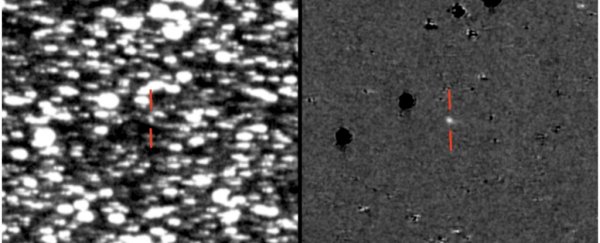Editor's note (1 June 2020): The asteroid been re-classified as a comet with a chaotic orbit - it's not a new type of asteroid. You can read more about the update here.
Original story: We tend to think of asteroids and comets as pretty strictly delineated categories.
Comets have long, looping orbits and are loaded up with volatile ices that sublimate, generating a dusty, misty halo and tail when the comet comes close to the Sun. Asteroids, on the other hand, are generally considered rocky, dry and inert, with orbits in the Solar System similar to those of the planets.
Every now and again, though, we come across something that challenges these definitions. And a newly discovered asteroid called 2019 LD2 is truly special - an asteroid of a kind we've never seen before.
It has an asteroid-like orbit, but a comet-like tail. That's rare, but not unknown - we call asteroids that exhibit comet-like characteristics (such as outgassing and sublimation) active asteroids. It's not the what, but the where that makes 2019 LD2 unique.
You see, the object shares its orbit with Jupiter, in an asteroid swarm known as the Jupiter Trojans. And it's the first Jupiter Trojan astronomers have ever seen spewing out gas like a comet would.
2019 LD2 first caught astronomers' attention in early June of last year, when the University of Hawaiʻi's Asteroid Terrestrial-impact Last Alert System (ATLAS) detected a faint new signal that appeared to be an asteroid in the Trojan group.
Follow-up observations came quickly. On June 10, astronomers using ATLAS noticed what appeared to be comet-like behaviour. On June 11 and 13, astronomers using the Las Cumbres Observatory found the same features. And in July 2019, new ATLAS images were the clincher: it was faint, but it was there, a trailing comet-like tail.
Further observations from that point had to be put on hold as the Jupiter Trojan swarm moved behind the Sun, where we can't see them. But they recently reemerged, and last month, astronomers took another look.
There was 2019 LD2, still flaunting a tail like a fabulous cosmic bride; it was probably doing so continuously for all that time. Because of its unusual orbit, astronomers are intrigued as to what processes could be driving 2019 LD2's unique outgassing.
There are thousands of asteroids in the Jupiter Trojan category, divided into two distinct groups. One group of Trojans orbits in front of Jupiter (this is where 2019 LD2 is), and the other trails behind it, in curved regions centring on the planet's Lagrangian points.
These are spots where the combined gravitational forces of two larger bodies (in this case Jupiter and the Sun) create a small area of gravitational stability.

The Lagrangian points generated by Earth's gravitational interactions with the Sun and Moon are actually really useful for things like space telescopes and relay satellites, but Jupiter's provide the inner Solar System with an essential service, acting as a net that prevents space rocks from flying willy-nilly and smashing into other planets.
The Jupiter Trojans are thought to have been swept up around 4 billion years ago, a period when the Solar System planets are thought to have been migrating into their current position. If that's how long they have been sharing Jovian space, any ice they may have had on their surface should have sublimated long ago.
But what if the ice is inside the asteroids?
"We have believed for decades that Trojan asteroids should have large amounts of ice beneath their surfaces, but never had any evidence until now," said astronomer Alan Fitzsimmons of Queen's University Belfast in Ireland.
"ATLAS has shown that the predictions of their icy nature may well be correct."
If 2019 LD2 had recently collided with another chunk of rock, the impact could have dislodged enough material to expose this previously sealed ice, allowing it to sublimate and outgas. It's also possible that 2019 LD2 was a stray recently captured by Jupiter from farther out in the Solar System, where it's cold enough for ice to stick around.
The Jupiter Trojans are pretty hard to study, but we could learn a lot from taking a closer look at this weirdo. Astronomers put in a request in December of last year to do just that using the Spitzer Space Telescope.
"As this object is the first of its kind, the detection of gas will be immensely exciting as it will provide first constraints on the volatile contents of the Trojan population measured from one of its members with implications on testing Solar System evolution models involving the capture of Trojans during the instability of the gas giants," they wrote.
"In either case of the volatile gases being detection or not detected, we expect the results to be high-impact as it allows us to characterise the activity mechanism of this novel object."
Sadly, Spitzer was retired in January of this year. But the new April observations flag 2019 LD2 as a very strong object of interest, and we know that this is not the last we're going to hear of the strange little space rock.
And hey, NASA will be launching the first spacecraft, Lucy, to visit the Jupiter Trojans next year. It'll take a few years to get there, and 2019 LD2 is not on the visitation schedule, but maybe it will be able to capture a few flyby observations as it passes through.
Editor's note (1 June 2020): The asteroid been re-classified as a comet with a chaotic orbit - it's not a new type of asteroid. You can read more about the update here.
